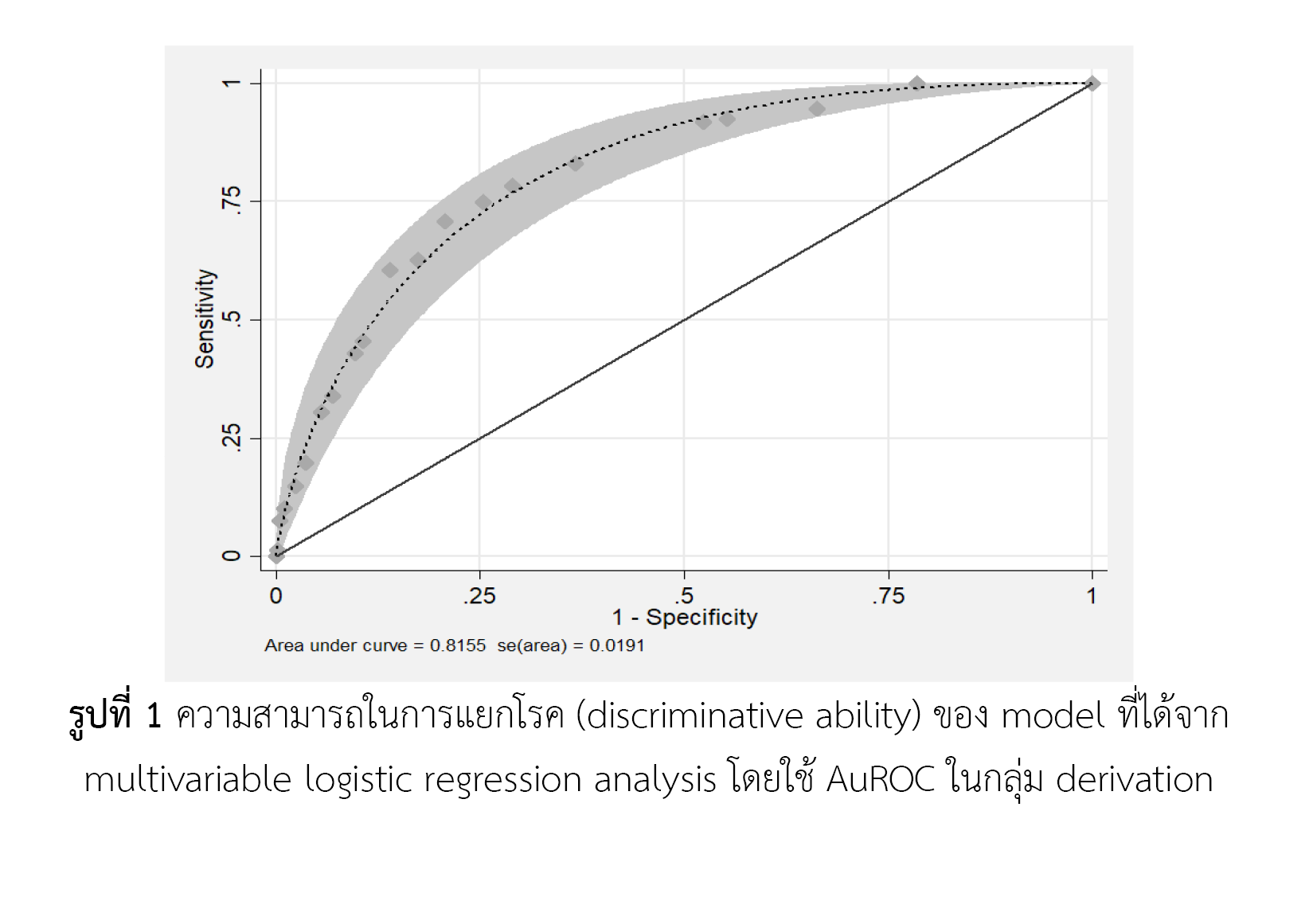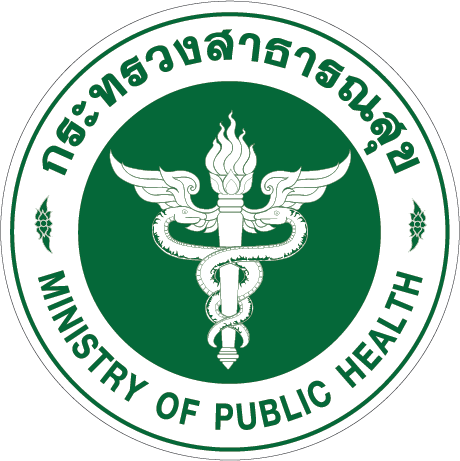Simplified Predictive Scoring for Mortality in Patients with Multidrug-resistant Acinetobacter baumannii Infection in Phrae Hospital
Keywords:
multidrug-resistant Acinetobacter baumannii, mortality, risk factor, scoringAbstract
Background: Mortality from multidrug-resistant Acinetobacter baumannii is a crucial health crisis international. At present we do not have any simplified screening tools to forecast the risk of mortality related with multidrug-resistant A. baumannii infection.
Objectives: The objective of this study was to develop a screening tool to forecast mortality in participants with multidrug-resistant A. baumannii infection in Phrae Hospital.
Methods: A retrospective cohort study was conducted by collecting data from electronic database in Phrae Hospital period from October 1st, 2017 to March 31st, 2021. Univariable and multivariable logistic regressions were used to identify potential risk factors. The regression coefficients were transformed into item scores and added up to a total score. The prediction power of the model was determined by the area under the receiver operating characteristic curve (AuROC) and goodness-of-fit. The scoring scheme was applied in validation cohort to test the performance.
Results: Six clinical risk factors, namely immunocompromise host, chronic obstructive pulmonary disease, intensive care unit admission, patients who on Endotracheal tube, septic shock, and use of antibiotics within the past 3 months. The model showed good power of prediction (AuROC 76.21%). The positive likelihood ratio of low risk and high risk were 1.50 (95%CI: 1.27-1.77) and 4.50 (95%CI: 2.65-7.66), respectively.
Conclusion: The screening tool with six risk predictors provided a useful prediction index for mortality in participants with multidrug-resistant A. baumannii infection. However, further external validation of the tool is warranted prior to its utilization in routine clinical practice.
References
Anudit C, Kooltheat N, Potup P, Pankla Sranujit R, Usuwanthim K. Nosocomial infection of multidrug-resistant Acinetobacter baumannii in Thailand. Am J Infect Control. 2016;44(10):1161-3.
Wong D, Nielsen TB, Bonomo RA, Pantapalangkoor P, Luna B, Spellberg B. Clinical and pathophysiological overview of Acinetobacter infections: A century of challenges. Clin Microbiol Rev. 2017 Jan;30(1):409-47.
Ilsan NA, Lee Y-J, Kuo S-C, Lee I-H, Huang T-W. Antimicrobial resistance mechanisms and virulence of colistin and carbapenem-resistant Acinetobacter baumannii isolated from a teaching hospital in Taiwan. Microorganisms. 2021;9(6):1295.
Wisplinghoff H, Bischoff T, Tallent SM, Seifert H, Wenzel RP, Edmond MB. Nosocomial bloodstream infections in US hospitals: Analysis of 24,179 cases from a prospective nationwide surveillance study. Clin Infect Dis an Off Publ Infect Dis Soc Am. 2004;39(3):309-17.
Alotaibi T, Abuhaimed A, Alshahrani M, Albdelhady A, Almubarak Y, Almasari O. Prevalence of multidrug-resistant Acinetobacter baumannii in a critical care setting: A tertiary teaching hospital experience. SAGE open Med. 2021;9:20503121211001144. doi: 10.1177/20503121211001144.
Onraj W, Kridsada S. Epidemics of multidrug resistant Acinetobacter baumannii in Buengkan hospital, Thailand, 2016 -2019. Dep Heal Serv Support J [Internet]. 2022;18(1):31-8. Available from: https://hss.moph.go.th/fileupload_doc/2022-05-03-1-22-105432236.pdf
Sunenshine RH, Wright M-O, Maragakis LL, Harris AD, Song X, Hebden J, et al. Multidrug-resistant Acinetobacter infection mortality rate and length of hospitalization. Emerg Infect Dis. 2007;13(1):97-103.
Phumart P, Phodha T, Thamlikitkul V, Riewpaiboon A, Prakongsai P, Limwattananon S. Health and economic impacts of antimicrobial resistant infections in Thailand : A preliminary study. J Heal Syst Res [Internet]. 2012;6(3):352-60. Available from: https://kb.hsri.or.th/dspace/bitstream/handle/11228/3699/hsri-journal-v6n3-p352-360.pdf?sequence=2&isAllowed=y
Zhou H, Yao Y, Zhu B, Ren D, Yang Q, Fu Y, et al. Risk factors for acquisition and mortality of multidrug-resistant Acinetobacter baumannii bacteremia: A retrospective study from a Chinese hospital. Medicine (Baltimore). 2019;98(13):e14937. doi: 10.1097/MD.0000000000014937.
Phodha T, Riewpaiboon A, Malathum K, Coyte PC. Annual relative increased in inpatient mortality from antimicrobial resistant nosocomial infections in Thailand. Epidemiol Infect. 2019;147:e133. doi: 10.1017/S0950268818003436.
Perez F, Hujer AM, Hujer KM, Decker BK, Rather PN, Bonomo RA. Global challenge of multidrug-resistant Acinetobacter baumannii. Antimicrob agents chemother. 2007;51(10):3471-84.
Manchanda V, Sanchaita S, Singh N. Multidrug resistant acinetobacter. J Glob Infect Dis. 2010;2(3):291-304. doi: 10.4103/0974-777X.68538.
Busani S, Serafini G, Mantovani E, Venturelli C, Giannella M, Viale P, et al. Mortality in patients with septic shock by multidrug resistant bacteria: Risk factors and Impact of sepsis treatments. J Intensive Care Med. 2019;34(1):48-54.
Jung JY, Park MS, Kim SE, Park BH, Son JY, Kim EY, et al. Risk factors for multi-drug resistant Acinetobacter baumannii bacteremia in patients with colonization in the intensive care unit. BMC Infect Dis. 2010;10(1):228. doi: 10.1186/1471-2334-10-228.
Tosi M, Erika R, Biasi S, Munari E, Venturelli S, Coloretti I, et al. Multidrug resistant bacteria in critically ill patients: A step further antibiotic therapy. J Emerg Crit Care Med. 2018;2:103-11. doi: 10.21037/jeccm.2018.11.08.
Roy S, Chowdhury G, Mukhopadhyay AK, Dutta S, Basu S. Convergence of biofilm formation and antibiotic resistance in Acinetobacter baumannii infection. Front Med. 2022;9:793615. doi: 10.3389/fmed.2022.793615.
Nseir S, Di Pompeo C, Cavestri B, Jozefowicz E, Nyunga M, Soubrier S, et al. Multiple-drug-resistant bacteria in patients with severe acute exacerbation of chronic obstructive pulmonary disease: Prevalence, risk factors, and outcome. Crit Care Med. 2006;34(12):2959-66.
Chen G, Xu K, Sun F, Sun Y, Kong Z, Fang B. Risk factors of multidrug-resistant bacteria in lower respiratory tract infections: A systematic review and meta-analysis. Can J Infect Dis Med Microbiol. 2020;2020:7268519. doi: 10.1155/2020/7268519.
Gunalan A, Sarumathi D, Sastry AS, Ramanathan V, Rajaa S, Sistla S. Effect of combined colistin and meropenem against meropenem resistant Acinetobacter baumannii and Pseudomonas aeruginosa by checkerboard method: A cross sectional analytical study. Indian J Pharmacol. 2021;53(3):207-12.
Saelim W, Changpradub D, Thunyaharn S, Juntanawiwat P, Nulsopapon P, Santimaleeworagun W. Colistin plus sulbactam or fosfomycin against carbapenem-resistant Acinetobacter baumannii: Improved efficacy or decreased risk of nephrotoxicity? Infect Chemother. 2021;53(1):128-40.

Downloads
Published
How to Cite
Issue
Section
License
Copyright (c) 2022 Health Administration Division, Office of the Permanent Secretary, Ministry of Public Health and The Society of Hospital Pharmacist, Ministry of Public Health

This work is licensed under a Creative Commons Attribution-NonCommercial-NoDerivatives 4.0 International License.
ข้อความภายในบทความที่ตีพิมพ์ในวารสารเภสัชกรรมคลินิกทั้งหมด รวมถึงรูปภาพประกอบ ตาราง เป็นลิขสิทธิ์ของกองบริหารการสาธารณสุข สำนักงานปลัดกระทรวงสาธารณสุข และ ชมรมเภสัชกรโรงพยาบาลกระทรวงสาธารณสุข การนำเนื้อหา ข้อความหรือข้อคิดเห็น รูปภาพ ตาราง ของบทความไปจัดพิมพ์เผยแพร่ในรูปแบบต่าง ๆ เพื่อใช้ประโยชน์ในเชิงพาณิชย์ ต้องได้รับอนุญาตจากกองบรรณาธิการวารสารเภสัชกรรมคลินิกอย่างเป็นลายลักษณ์อักษร
กองบริหารการสาธารณสุข สำนักงานปลัดกระทรวงสาธารณสุข และ ชมรมเภสัชกรโรงพยาบาลกระทรวงสาธารณสุข อนุญาตให้สามารถนำไฟล์บทความไปใช้ประโยชน์และเผยแพร่ต่อได้ โดยอยู่ภายใต้เงื่อนไขสัญญาอนุญาตครีเอทีฟคอมมอน (Creative Commons License: CC) โดย ต้องแสดงที่มาจากวารสาร – ไม่ใช้เพื่อการค้า – ห้ามแก้ไขดัดแปลง, Attribution-NonCommercial-NoDerivatives 4.0 International (CC BY-NC-ND 4.0)
ข้อความที่ปรากฏในบทความในวารสารเป็นความคิดเห็นส่วนตัวของผู้เขียนแต่ละท่านไม่เกี่ยวข้องกับกองบริหารการสาธารณสุข สำนักงานปลัดกระทรวงสาธารณสุข และ ชมรมเภสัชกรโรงพยาบาลกระทรวงสาธารณสุข และบุคลากรในกองฯ หรือ ชมรมฯ แต่อย่างใด ความรับผิดชอบองค์ประกอบทั้งหมดของบทความแต่ละเรื่องเป็นของผู้เขียนแต่ละท่าน หากมีความผิดพลาดใด ๆ ผู้เขียนแต่ละท่านจะรับผิดชอบบทความของตนเอง ตลอดจนความรับผิดชอบด้านเนื้อหาและการตรวจร่างบทความเป็นของผู้เขียน ไม่เกี่ยวข้องกับกองบรรณาธิการ



